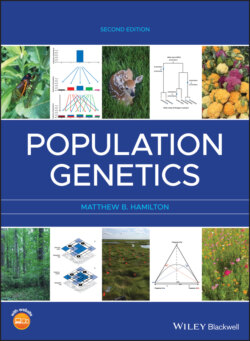Читать книгу Population Genetics - Matthew B. Hamilton - Страница 33
2.5 The fixation index and heterozygosity
ОглавлениеThe fixation index (F) measures deviation from Hardy–Weinberg expected heterozygote frequencies.
Examples of mating systems and F in wild populations.
Observed and expected heterozygosity.
The mating patterns of actual organisms frequently do not exhibit the random mating assumed by Hardy–Weinberg. In fact, many species exhibit mating systems that create predictable deviations from Hardy–Weinberg expected genotype frequencies. The term assortative mating is used to describe patterns of non‐random mating. Positive assortative mating describes the case when individuals with like genotypes or phenotypes tend to mate. Negative assortative mating (also called disassortative mating) occurs when individuals with unlike genotypes or phenotypes tend to mate. Both of these general types of non‐random mating will impact expected genotype frequencies in a population. This section describes the impacts of non‐random mating on genotype frequencies and introduces a commonly used measure of non‐random mating that can be utilized to estimate mating patterns in natural populations.
Mating among related individuals, termed consanguineous mating or biparental inbreeding, increases the probability that the resulting progeny are homozygous compared to random mating. This occurs since relatives, by definition, are more likely than two random individuals to share one or two alleles that were inherited from ancestors they share in common (this makes mating among relatives a form of assortative mating). Therefore, when related individuals mate, their progeny have a higher chance of receiving the same allele from both parents, giving them a greater chance of having a homozygous genotype. Sexual autogamy or self‐fertilization is an extreme example of consanguineous mating where an individual can mate with itself by virtue of possessing reproductive organs of both sexes. Many plants and some animals, such as the nematode Caenorhabditis elegans, are hermaphrodites that can mate with themselves.
There are also cases of disassortative mating, where individuals with unlike genotypes have a higher probability of mating. A classic example in mammals is mating based on genotypes at major histocompatibility complex (MHC) loci, which produce proteins involved in self/non‐self recognition in immune response. Mice are able to recognize individuals with similar MHC genotypes via odor, and based on these odors, avoid mating with individuals possessing a similar MHC genotype. Experiments where young mice were raised in nests of either their true parents or foster parents (called cross‐fostering) showed that mice learn to avoid mating with individuals possessing odor cues similar to their nest‐mates' rather than avoiding MHC‐similar individuals per se (Penn and Potts 1998). This suggests that mice learn the odor of family members in the nest and avoid mating with individuals with similar odors, indirectly leading to disassortative mating at MHC loci as well as the avoidance of consanguineous mating. One hypothesis to explain the evolution of disassortative mating at MHC loci is that the behavior is adaptive since progeny with higher heterozygosity at MHC loci may have more effective immune response. There is evidence that some animals prefer mates with dissimilar MHC genotypes (e.g. Miller et al. 2009), while, in humans, the possibility remains controversial (Qiao et al. 2018).
The effects of non‐random mating on genotype frequencies can be measured by comparing Hardy–Weinberg expected frequency of heterozygotes, which assumes random mating, with observed heterozygote frequencies in a population. A quantity called the fixation index, symbolized by F (f is reserved for the coancestry coefficient introduced later in Section 2.6.), is commonly used to compare how much heterozygosity is present in an actual population relative to the expected levels of heterozygosity under random mating
(2.9)
where He is the Hardy–Weinberg expected frequency of heterozygotes based on population allele frequencies and Ho is the observed frequency of heterozygotes. Dividing the difference between the expected and observed heterozygosity by the expected heterozygosity expresses the difference in the numerator as a percentage of the expected heterozygosity. Even if the difference in the numerator may seem small, it may be large relative to the expected heterozygosity. Dividing by the expected heterozygosity also puts F on a convenient scale of −1 and + 1. Negative values indicate heterozygote excess and positive values indicate homozygote excess relative to Hardy–Weinberg expectations. In fact, the fixation index can be interpreted as the correlation between the two alleles sampled to make a diploid genotype (see the Appendix for an introduction to correlation if necessary). Given that one allele has been sampled from the population, if the second allele tends to be identical, there is a positive correlation (e.g. A and then A or a and then a); if the second allele tends to be different, there is a negative correlation (e.g. A and then a or a and then A); and if the second allele is independent, there is no correlation (e.g. equally likely to be A or a). With random mating, no correlation is expected between the first and second allele sampled to make a diploid genotype.
